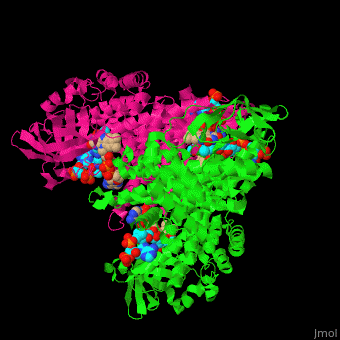Acyl-CoA dehydrogenase
From Proteopedia
FunctionAcyl-CoA dehydrogenase (ACDH) catalyzes the introduction of a double bond between C2 and C3 of the thio-ester CoA substrate. This is the first reaction in fatty acid metabolism which produces acetyl-CoA. FAD is the cofactor of ACDH activity. ACDH is classified according to the length of its substrates as short- (SCAD), medium- (MCAD), very- and very long-chain (VLCAD) ACDH. MCAD can bind a broad range of chain length acyl-CoA substrates.[1] See also Beta oxidation and Glutaryl-CoA dehydrogenase.
DiseaseImpairment of the activity of ACDH causes a variety of diseases associated with lack of fatty acid metabolism. MCAD mutations are associated with Sudden Infant Death and with Medium-chain Acyl-CoA Dehydrogenase Deficiency (MCADD)[4]. For details see Investigating the Mechanisms of Active Site Mutations to the 1T9G WT MCAD Protein to Better Understand Medium Chain Acyl-CoA Dehydrogenase Deficiency (MCADD). SCAD deficiency is a recessive disorder of fatty acid β-oxidation. Structural highlightsSCAD is a homodimer with a single FAD binding site. MCAD is a homotetramer with 4 FAD binding sites in the subunits interface and 4 binding sites for acyl-CoA substrate within each monomer.
3D structures of acyl-CoA dehydrogenase |
| |||||||||||
References
- ↑ Thorpe C, Kim JJ. Structure and mechanism of action of the acyl-CoA dehydrogenases. FASEB J. 1995 Jun;9(9):718-25. PMID:7601336
- ↑ Mohsen AW, Anderson BD, Volchenboum SL, Battaile KP, Tiffany K, Roberts D, Kim JJ, Vockley J. Characterization of molecular defects in isovaleryl-CoA dehydrogenase in patients with isovaleric acidemia. Biochemistry. 1998 Jul 14;37(28):10325-35. PMID:9665741 doi:10.1021/bi973096r
- ↑ Yang SY, He XY, Schulz H. 3-Hydroxyacyl-CoA dehydrogenase and short chain 3-hydroxyacyl-CoA dehydrogenase in human health and disease. FEBS J. 2005 Oct;272(19):4874-83. PMID:16176262 doi:10.1111/j.1742-4658.2005.04911.x
- ↑ Ibrahim SA, Temtem T. Medium-Chain Acyl-CoA Dehydrogenase Deficiency. PMID:32809672
- ↑ Battaile KP, Molin-Case J, Paschke R, Wang M, Bennett D, Vockley J, Kim JJ. Crystal structure of rat short chain acyl-CoA dehydrogenase complexed with acetoacetyl-CoA: comparison with other acyl-CoA dehydrogenases. J Biol Chem. 2002 Apr 5;277(14):12200-7. Epub 2002 Jan 25. PMID:11812788 doi:10.1074/jbc.M111296200

